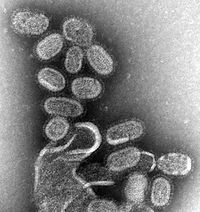
Photo from wikipedia
OBJECTIVE Nosocomial transmission of influenza is a major concern for infection control. We aimed to dissect transmission dynamics of influenza, including asymptomatic transmission events, in acute care. DESIGN Prospective surveillance… Click to show full abstract
OBJECTIVE Nosocomial transmission of influenza is a major concern for infection control. We aimed to dissect transmission dynamics of influenza, including asymptomatic transmission events, in acute care. DESIGN Prospective surveillance study during 2 influenza seasons. SETTING Tertiary-care hospital. PARTICIPANTS Volunteer sample of inpatients on medical wards and healthcare workers (HCWs). METHODS Participants provided daily illness diaries and nasal swabs for influenza A and B detection and whole-genome sequencing for phylogenetic analyses. Contacts between study participants were tracked. Secondary influenza attack rates were calculated based on spatial and temporal proximity and phylogenetic evidence for transmission. RESULTS In total, 152 HCWs and 542 inpatients were included; 16 HCWs (10.5%) and 19 inpatients (3.5%) tested positive for influenza on 109 study days. Study participants had symptoms of disease on most of the days they tested positive for influenza (83.1% and 91.9% for HCWs and inpatients, respectively). Also, 11(15.5%) of 71 influenza-positive swabs among HCWs and 3 (7.9%) of 38 influenza-positive swabs among inpatients were collected on days without symptoms; 2 (12.5%) of 16 HCWs and 2 (10.5%) of 19 inpatients remained fully asymptomatic. The secondary attack rate was low: we recorded 1 transmission event over 159 contact days (0.6%) that originated from a symptomatic case. No transmission event occurred in 61 monitored days of contacts with asymptomatic influenza-positive individuals. CONCLUSIONS Influenza in acute care is common, and individuals regularly shed influenza virus without harboring symptoms. Nevertheless, both symptomatic and asymptomatic transmission events proved rare. We suggest that healthcare-associated influenza prevention strategies that are based on preseason vaccination and barrier precautions for symptomatic individuals seem to be effective.
Journal Title: Infection control and hospital epidemiology
Year Published: 2021
Link to full text (if available)
Share on Social Media: Sign Up to like & get
recommendations!